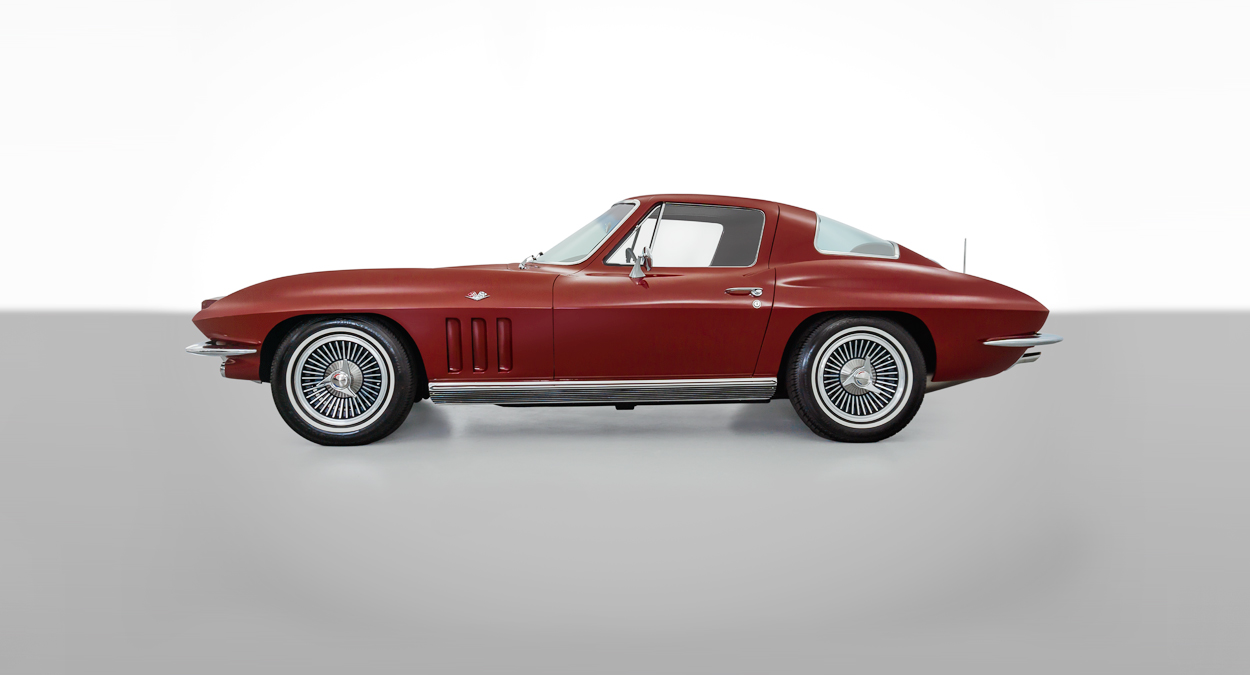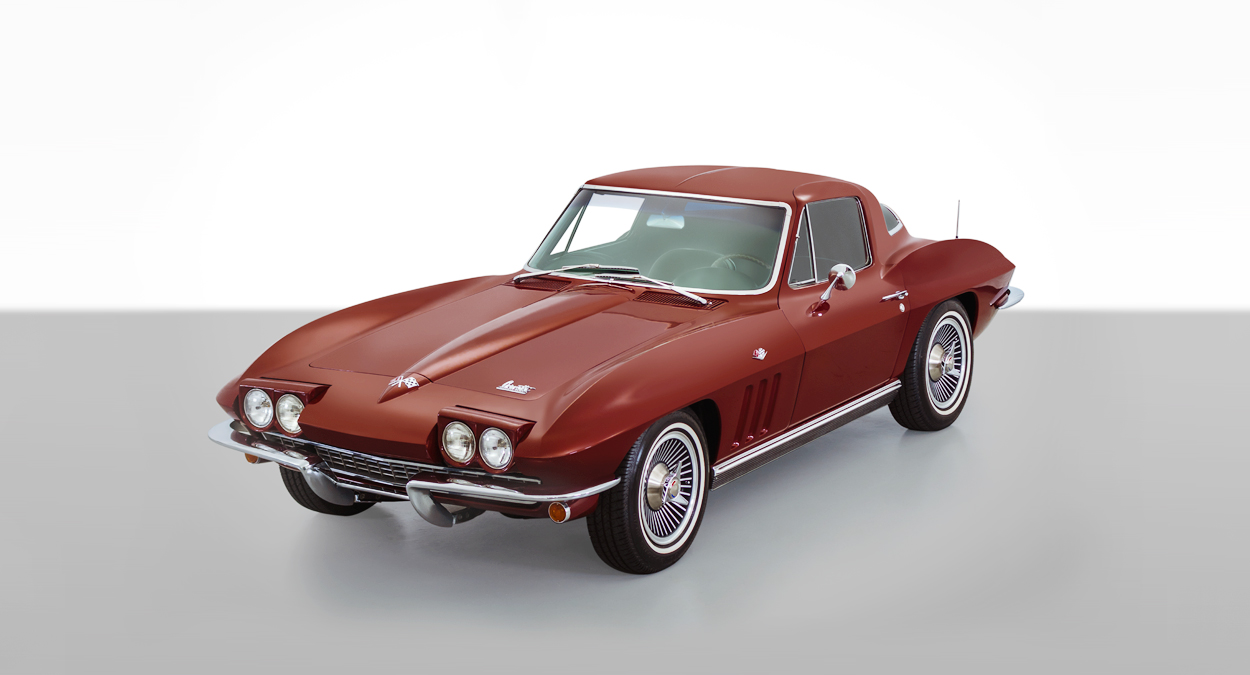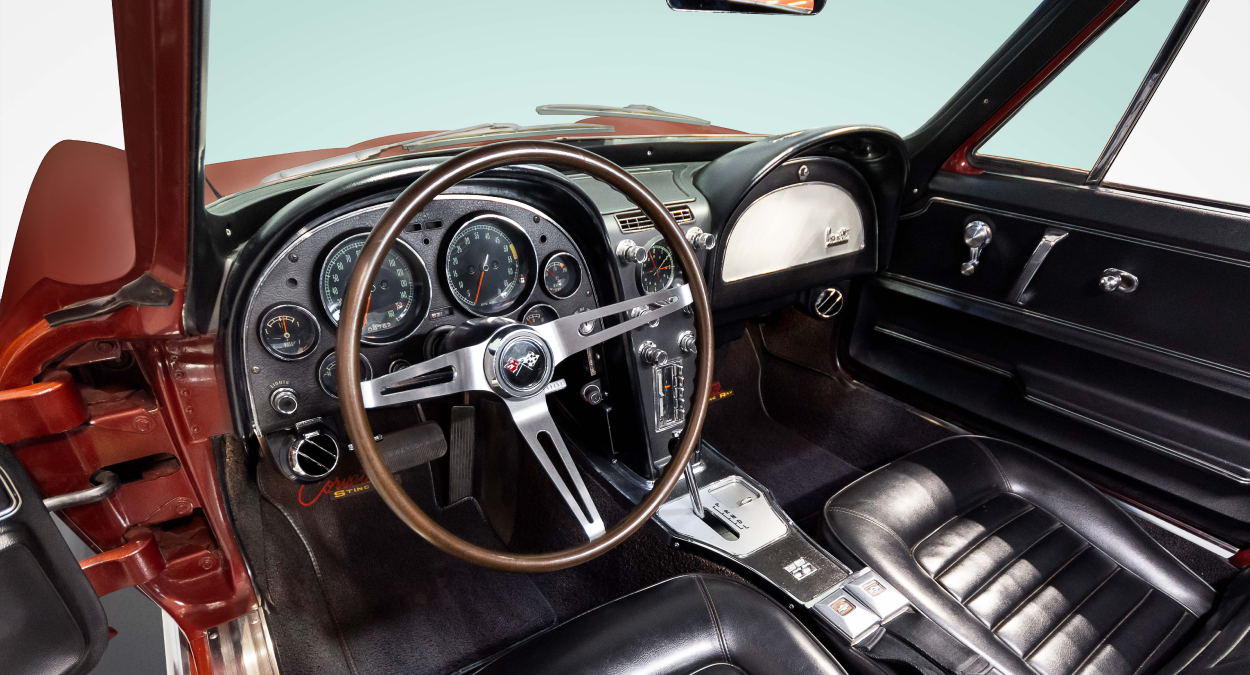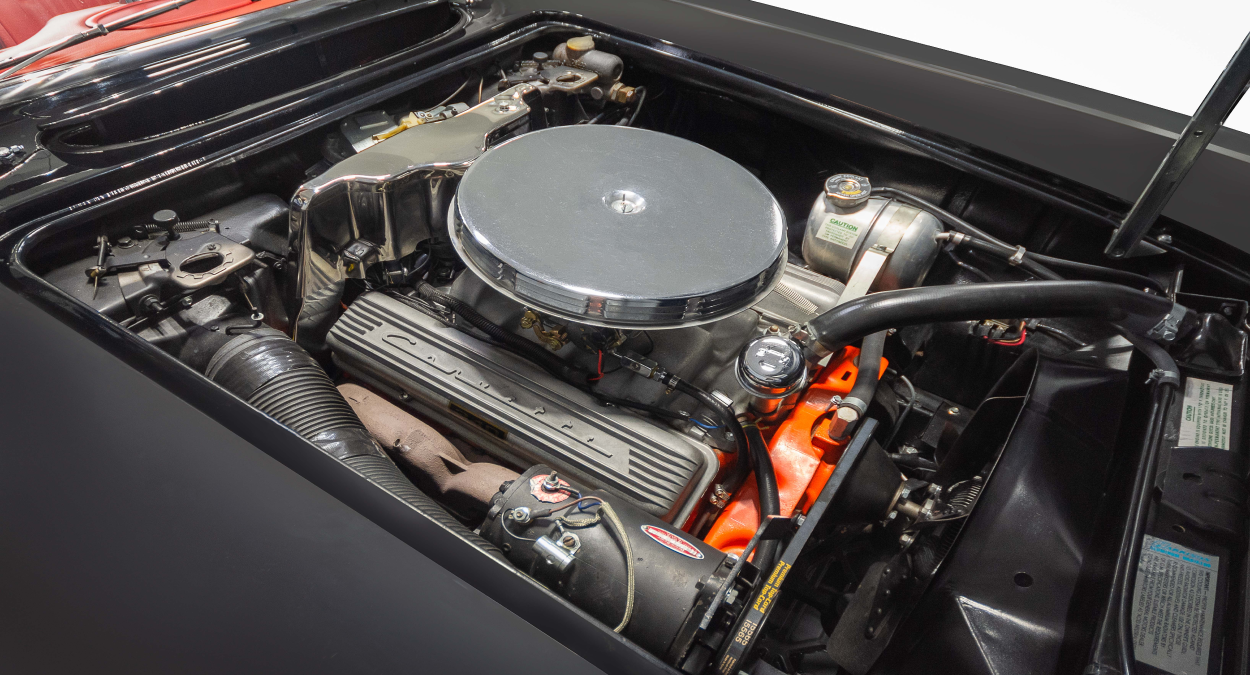

1966 Corvette Stingray Sport Coupe
Click any photo to view fullscreen. Mobile users can pinch to zoom. Tap ‘X’ to close.
SPEED
SPECIFICATIONS
- Mileage 8691
- Engine 327ci 300HP V-8
- Rare Powerglide Automatic 2 Speed Transmission
- Sport Master Disc Brakes
- two-speed electric wind-shield wipers with the pushbutton washer
1966 Corvette Stingray Sport Coupe
With big-block V8s being the order of the day, there was less demand for the 327, so small-block offerings were cut from five to two for 1966, and only the basic 300- and 350-bhp versions were retained. Both required premium fuel on compression ratios well over 10.0:1, no, they did not have the rocket-like thrust of the 427s, but their performance was impressive all the same. As before, both could be teamed with the Powerglide automatic.
The 1966 model’s frontal appearance was mildly altered with an eggcrate grille insert to replace the previous horizontal bars, and the coupe lost its roof-mounted extractor vents, which had proven inefficient. Corvettes also received an emblem in the corner of the hood for 1966. Head rests were a new option. One rare option was the coupe in Milano Maroon with the Powerglide Automatic option with power windows and air conditioning from factory. which records show production numbered only 7 convertibles and 33 coupes. This relative lack of change reflected plans to bring out an all-new Corvette for 1967. It certainly did not reflect a fall-off in the car’s popularity, however. In fact, 1966 would prove another record-busting year, with volume rising to 27,720 units, up some 4,200 over 1965s sales.
Under the more familiar Corvette hood the 327-cubic-inch V8s – with 300 hp– certainly not pallid. First off, the 300-hp engine is now standard equipment … with 327-cu.in. displacement, a healthy 4-barrel carburetor, big intake-valve cylinder heads and 2 ½” diameter dual exhaust system. Second, the engine uses hydraulic calve lifters for smoothness and quiet operation new automatic choke on every engine is more responsive to engine temperature during operation. Full dual exhausts are supplied with every engine.
Corvette’s big Sport-Master disc brakes deliver nearly unbelievable stopping power. These binders are hydraulic caliper-type unites with 11.75” cast-iron discs, front and rear. In addition to natural air flow around the outside surfaces, integrally cast internal cooling fins force air between the surfaces of the discs. Result? Cooler brake for fade resistance. Four caliper units, one at each wheel (they work like a pair of pliers), supply the squeeze through 86.3 square inches of woven asbestos linings. Corvette gives you a feeling of control through precise balance and rhythm. Key to this control is the all-independent suspension. In the front, variable-rate coil springs soak up small shocks and bumps; over big bumps, the springs maintain taut control. Anti-dive geometry is built into the upper control arm, and a front 0.750” dia. stabilizer bar, rubber-bushed, gives the ’66 Corvette a ride equally suited to casual boulevardeering or to more ambitious countryside demands. At the rear Corvette’s sophisticated independent suspension takes care of curves and bumps in a thoroughly professional way. Each wheel reacts to bumps individually without affecting the attitude of the other. The final drive assembly is mounted directly to the frame to reduce unspring weight. Without this extra weight, the rear wheels can (and do) respond to road surface stimuli quickly and smoothly. Each wheel is located by three links- a trailing arm from the frame to the rear wheel hub; a strut rod from the lower part of the differential case to the rear wheel hub and the tubular axle shaft (double universal-jointed). The trailing arm transfers acceleration and braking torque loads to the frame, while the combination of the strut rod and axle shaft locates the wheel laterally and allows a minimum of camber and tread change during wheel travel. Since all braking, accelerating and cornering loads are handled by the rear suspension linkage and transferred directly to the frame, the only function of the nine-leaf variable-rate rear spring is to cushion the ride; like the front springs, it soaks up small irregularities in its stride while remaining firm to large bumps. Direct-acting, double-action shock absorbers contain freon bags to help maintain proper action during extreme use. Corvette’s precise steering results from a happy combination of excellent vehicle balance and low-friction spherical-joint components. Faster steering provisions are built into the basic system as standard equipment. A telescopic steering column allows drivers to move the wheel through a range of three inches – without getting out of the driver’s seat. (The standard steering column is also adjustable with simple tools. A necessary foundation to tie all suspension and driveline components together in the Sting Ray’s frame. It has heft where it is necessary and strength without excess bulk. The five crossmember rails are spaced to facilitate advantageous location of engine, seats, suspension components and fuel tank. Frame design contributes to a low center of gravity and allows placement of major car components for outstanding vehicle handling. Corvette Sting Ray’s final drive assembly is something different among sports cars and certainly unique among American-made cars. We have already said that it is bolted to the frame. Three large rubber biscuits isolate the assembly from direct metal-to-metal contact to reduce noise and vibration transfer to the body from the rear suspension. Mounted to the frame in this manner, the assembly reacts with the body over bumps. Since it moves with the body and not the wheels, the going’s smoother and the engines can put their power on the ground where it belongs. And “axle-tramp” is gone. When Positraction is specified, power flows to the rear wheel with greatest traction, especially on muddy, slippery, or other irregular surfaces where traction under one wheel is unfavorable.
The first thing most Corvette enthusiasts will notice is the new bright metal grille styling. The shape gives the ’66 a rugged and handsome look. Just aft of the left-hand retractable headlight is the new nameplate. On the side of every ’66 Vette, a fresh new body sill molding adds elegance while newly styled standard wheel covers look for all the world like costly mag wheels. At the rear, backup lights are now standard. (These lights and other new standard items may not necessarily be illustrated in this catalog.) Of the ten exterior colors, four are brand-new including the Milano Maroon. Enhancing all these colors are new thin line-styled whitewall or gold-stripe tires that can be ordered. Other Sting Ray styling features continue virtually unchanged: exhaust louvers behind the front wheels (and on the hood of Turbo-Jet V8 models as well) to ventilate the engine compartment, retractable headlights, amber turn signal indicators, compound-curved body side glass, outside rearview mirror and aerodynamic lines that remain among the sleekest in the sports car world. While most enthusiasts know the entire body is made of fiber glass panels, it bears repeating for the latest class of aficionados. Convertible uses 35 in the sport coupe. In some areas, panels are riveted to a steel framework. In others, a strip of fiber glass is riveted to the framework and body panels are bonded to the strip. Sport coupe body uses sic rubber “biscuits” to cushion body from frame at attaching points; the convertible uses eight similar “biscuits.” Sealing and weather stripping remain among the best of any sports car. The wrap-over doors of the sport coupe are given special attention for weather-tightness; and they give an additional benefit-easy entry and exit. Wrap-around bumpers, front and rear, protect the body against causal damage; glare-reducing two-speed electric wind-shield wipers with the pushbutton washer help keep vision clear; weather-shielding makes frozen door locks almost a thing of the past and separate locked tire storage keeps interior stowage room at a maximum. Finally, Corvette’s sparkling Magic-Mirror acrylic lacquer finish stands up remarkably well against the effects of weather. The paint has high resistance to fading, staining, chipping, and chalking. If a body panel is damaged, the paint can be spot finished, eliminating the necessity of repainting an entire body area. Overall, the design concept has been fundamentally right since the Sting Ray’s inception; changed have been improvements on the basic design. Conclusion: To own and drive a 1966 Corvette is one of the most invigorating and exciting experiences in the whole of motordom.
Here is an interior that says “sports car” in an adventuresome way. Opening the door to a ’66 reveals new lushly styled seats. Sitting in them is comfort – pure and simple. Door pulls are bright metal for added luxury; crank-operated venti panes assure easy, positive operation. Your feet will rest comfortably on molded deep-twist carpet. Interior colors for 1966 include black, red, bright blue, saddle, silver, green, blue and white/blue; all are keyed to exterior body finish. The expanded vinyl is subtly textured for extra elegance. In the sport coupe, a new vinyl-covered foam headliner helps keep the interior quieter and has a new shatter-resistant inside rearview mirror. Other post touches; carpeted cowl side panels, padded sun visor, blended-air heater-defroster with three-speed blower, seat belt retractors, seat belt buckle-clips on the console and two-key locking system with an ignition switch that prevents turning to “Accessory” unintentionally. Behind the seats, an under-the-floor storage compartment hides valuables and stores tire tools as well. The luggage compartment is completely carpeted and encompasses over 10 cubic feet in the sport coupe unless you specify the 36-gallon fuel tank. Every true sports car driver wants to know what is going on when he drives. So, Corvette’s ’66 instrument panel tells you what’s going on in the engine compartment and on the road in a glance. Twin large-circle instruments house the speedometer and tachometer directly in front of the driver. Inside the speedometer is the odometer. Directly beneath these two instruments is a resettable trip odometer which registers mileage up to 999.9 including tenths. A small knob under the instrument panel affords easy operation. Flanking the large speedometer are electrically operated fuel level gauge, ammeter, and electric coolant temperature gauge. Rounding out the instruments are a cigarette lighter, headlight switch and retractor switch (a red signal blinks “Lights” if you turn on the headlights without raising them), hood release, parking brake and four-position ignition switch. Over on the passenger’s side, a built-in assist bar is integral with the padded instrument panel; a large locking glove box opens, the door becomes a convenient tray, and heater controls are accessible to both passenger and driver. Finally, when you order a radio, the controls are in the central console. Outside air vent pull handles are located on either side of the steering column directly below the instrument panel. When the parking brake has been left on and the engine started, a little red light lets you know. It blinks, “Brake.” Similarly, if you switch the headlights to high beam, another little red-light stares brightly at you. It is nice to feel looked after. All the wiring is color-coded for easy maintenance. Radio-equipped cars have bright metal shielding to suppress ignition noise and interference. Accessories are fused except for the headlamps and parking lights. They are controlled by circuit breakers.




